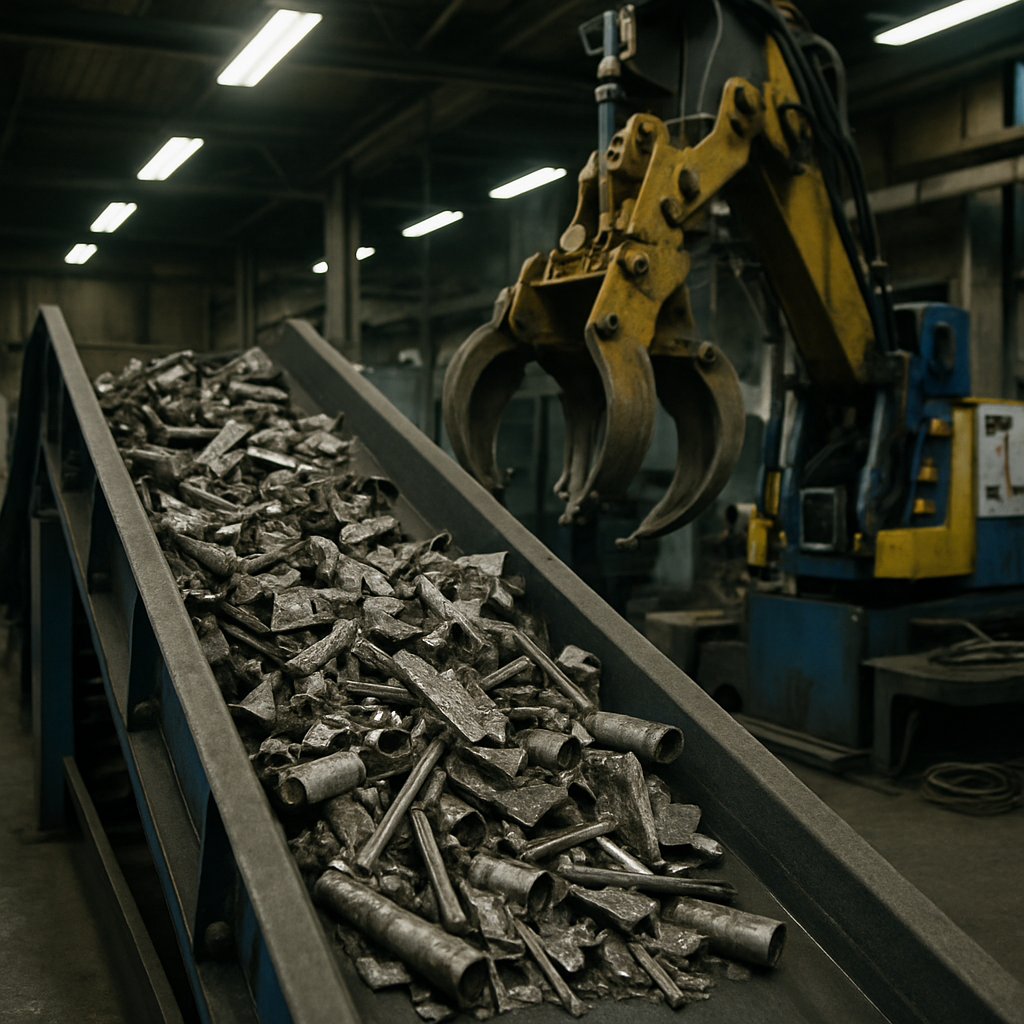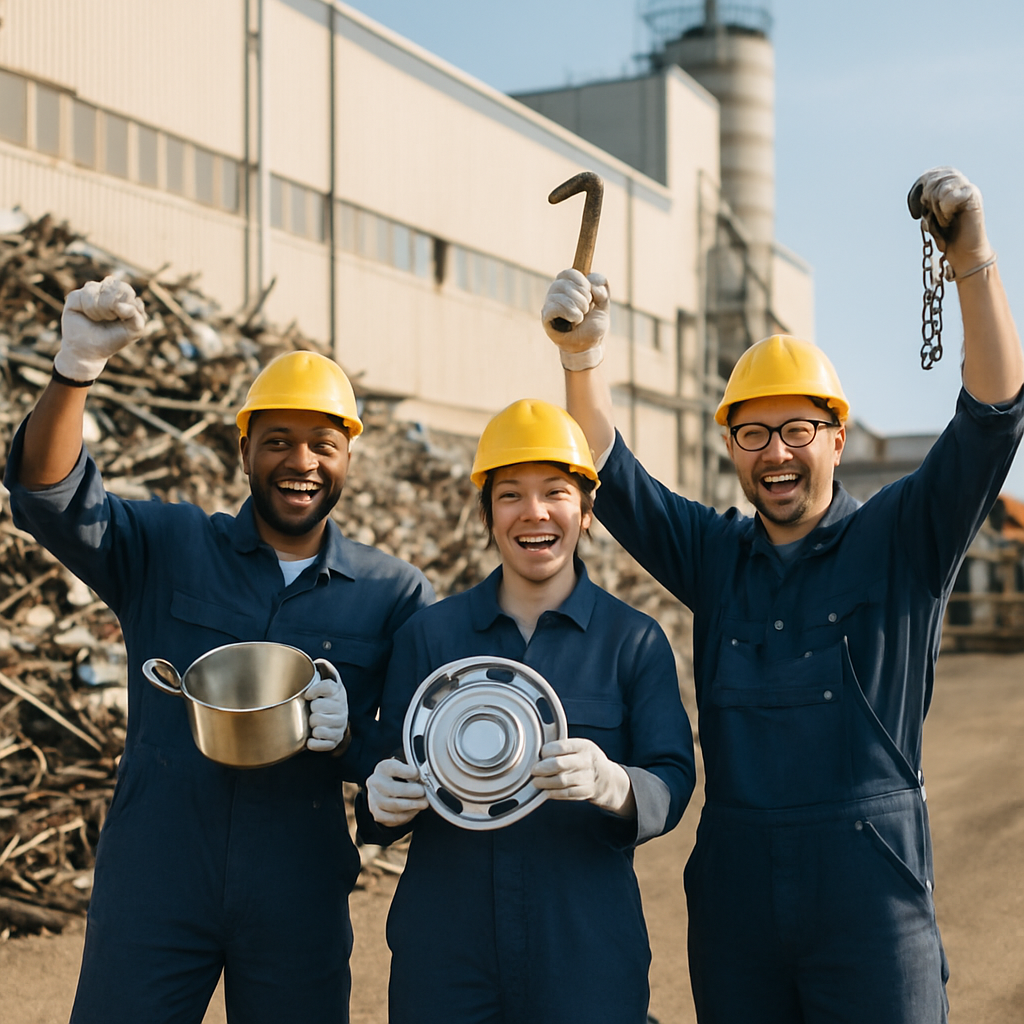5901 Botham Jean Blvd, Dallas, TX 75215
Scrap Steel Collection: Methods, Sources & Key Environmental Benefits
September 22, 2025Scrap steel collection forms the foundation of steel recycling efforts worldwide. This process involves gathering discarded steel materials that would otherwise end up in landfills. From small items like cans and hardware to large pieces such as appliances and construction materials, scrap steel collection captures valuable resources that can be recycled indefinitely without losing quality.
Steel is among the most recycled materials on the planet. The collection process starts with identifying steel items, which often respond to magnets due to their ferrous content. Collection methods vary based on volume and material types. For smaller operations, collectors might use pickup trucks, while larger operations employ specialized vehicles with hydraulic lifting equipment to handle heavier loads.
The environmental impact of scrap steel collection is substantial. Recycling one ton of steel saves approximately 2,500 pounds of iron ore, 1,400 pounds of coal, and 120 pounds of limestone. This process consumes 60% less energy than producing new steel from raw materials, making steel collection a critical component in resource conservation and sustainable waste management systems.
How is Scrap Steel Collected?

Scrap steel collection begins with identifying and separating materials accurately. Collection happens at various locations, including construction sites, industrial facilities, and residential areas. The steel recycling journey starts with this vital initial step in the circular economy.
Construction sites generate significant amounts of scrap steel from leftover materials, demolished structures, and replaced components. Industrial facilities regularly produce scrap from manufacturing processes, equipment upgrades, and facility maintenance. Households contribute through discarded appliances, furniture with metal components, and various consumer goods.
Collection Methods for Businesses
Commercial and industrial organizations typically implement structured collection systems. Most large facilities use designated containers specifically for scrap steel. These containers prevent contamination and simplify the sorting process.
Many businesses establish partnerships with local scrap yards or recycling centers. These relationships facilitate regular pickup schedules based on volume and frequency needs. Some recycling facilities offer container drop-off services for high-volume clients.
Industrial scrap is particularly valuable because it is often cleaner and more uniform than other sources. Companies generate what recyclers call “prompt scrap” during manufacturing processes. This material typically returns to steel mills within a year through established contracts.
Residential Collection Approaches
Individuals can contribute to steel recycling through several methods. Many municipalities offer curbside recycling programs that accept steel cans and small metal items. For larger steel items, residents can transport materials directly to local recycling centers or scrap yards.
When collecting steel at home, use a magnet to identify ferrous metals. Steel will stick to the magnet, while non-ferrous metals like aluminum will not. Keep a separate container for steel items to prevent mixing with other materials.
Some communities host special collection events for bulky metal items or hazardous materials. These events provide convenient opportunities to recycle larger steel objects that do not fit in standard recycling bins.
Effective Collection Practices
For efficient steel collection, several best practices apply across all settings. Use sturdy, clearly labeled containers to separate different metal types. This prevents contamination and increases the value of your scrap.
Remove non-metal attachments whenever possible. Items like plastic handles, rubber gaskets, and electronic components should be detached before recycling. Clean materials fetch higher prices and recycle more efficiently.
For safety, wear protective gloves when handling scrap steel. Watch for sharp edges and never compact materials by hand. Store collected scrap in a dry area to prevent rust, which can reduce its value.
Commercial collectors should maintain records of their scrap generation. Tracking volumes and types helps optimize collection schedules and identify waste reduction opportunities.
Some recycling facilities use advanced technology for collection and sorting. Magnetic separators efficiently extract ferrous metals from mixed materials. These powerful systems can process large volumes quickly and accurately.
The steel industry relies heavily on scrap collection. According to industry data, steel recycling saves enough energy annually to power millions of homes. Every ton of steel recycled conserves significant amounts of iron ore, coal, and limestone.
By implementing effective collection systems, both businesses and individuals contribute to resource conservation and reduce environmental impact. The steel you collect today becomes tomorrow’s infrastructure, vehicles, and consumer products.
What Happens After Scrap Steel is Collected?

After collection, scrap steel begins its transformation through a series of orchestrated steps. Each phase is crucial for converting discarded metal into valuable recycled steel products that meet industry standards.
Sorting and Separation
The first crucial step in processing scrap steel is thorough sorting. Workers and automated systems separate recyclable steel from non-recyclable materials. Powerful magnets efficiently identify and extract ferrous metals from the mix.
Modern recycling facilities employ sophisticated sorting technologies like X-ray Fluorescence (XRF) and Laser-Induced Breakdown Spectroscopy (LIBS). These methods analyze the chemical composition of scrap metal for proper categorization and separation.
Proper sorting directly impacts the quality of the final recycled product. Industry standards require that foreign materials in steel scrap must not exceed 2 percent by weight for optimal recycling results.
Processing and Size Reduction
Once sorted, the scrap steel undergoes processing to prepare it for melting. Large pieces are compacted using heavy-duty machines to reduce volume and optimize conveyor belt space. This compression makes the material more manageable for further processing.
Next comes shredding, where industrial shredders break down the compressed steel into smaller pieces. Facilities typically use hydraulic or electric power systems to drive these robust shredders. The smaller fragments melt more efficiently, requiring less energy than larger pieces would.
After shredding, the metal moves through additional separation systems to ensure purity. Eddy current separation techniques help remove any remaining non-ferrous materials from the steel scrap.
Melting and Purification
The processed scrap steel enters large electric arc furnaces (EAF) that reach temperatures exceeding 3,000 degrees Celsius. These extreme temperatures transform the solid scrap into molten metal. The furnaces use high-voltage electricity to generate the intense heat needed for complete melting.
During melting, oxygen and slag formers such as magnesium oxide and calcium oxide are added to the furnace. These additives promote slag formation on top of the molten steel. The slag layer acts as thermal insulation and captures impurities from the melted metal.
The purification process removes harmful contaminants such as sulfur, phosphorus, zinc, and tin. Without this crucial step, these impurities would compromise the recycled steel’s strength, weldability, and surface quality.
Solidification and Manufacturing
After purification, the liquid steel moves to a continuous casting system. The molten metal flows into water-cooled copper molds that form a solidified outer shell. The steel then passes through secondary cooling zones where water and air sprays further solidify the material.
Once solidified, cutting machines slice the steel into specific lengths based on intended applications. The most common form for recycled steel is bars, though it can also be formed into sheets, plates, strips, rails, rods, or coils.
The final step involves rolling the steel. This process shapes the metal into various profiles by passing it between rollers in a hot rolling mill. The compressive force from rolling alters the steel’s grain structure and reduces its thickness to meet precise specifications.
Distribution to Manufacturers
The newly processed recycled steel is now ready for its second life. It is transported to manufacturers who will use it as raw material for new products. These might include automobile parts, construction materials, appliances, or countless other steel-based items.
Steel’s remarkable property of infinite recyclability without quality degradation makes this process particularly valuable. Each recycling cycle saves approximately 75 percent of the energy that would be required to produce steel from raw materials.
Quality control testing occurs throughout this journey. Tests include metallurgical assessments, hardness evaluations, tension testing, fatigue analysis, and ultrasonic examinations. These ensure the recycled steel meets industry standards and specifications for its intended use.
Why is Scrap Steel Collection Important?

Scrap steel collection plays a crucial role in both environmental conservation and economic growth. Each ton of recycled steel saves about 2,500 pounds of iron ore, 1,400 pounds of coal, and 120 pounds of limestone from being extracted. This conservation of resources is just one aspect of the environmental benefits of steel recycling.
The energy savings from scrap steel recycling are significant, with the process requiring 75% less energy than making steel from virgin materials. This efficiency translates to approximately 16-19 gigajoules saved per ton of steel produced, reducing strain on power grids and dependence on fossil fuels.
Reducing carbon emissions is another key environmental benefit. Recycling steel generates 70-80% fewer CO2 emissions than traditional manufacturing methods. For each ton of steel recycled instead of produced from raw materials, about 1.5 tons of carbon dioxide emissions are prevented, helping to combat climate change.
Water conservation is also an advantage of steel recycling. Producing recycled steel requires 40-50% less water than primary production methods, saving around 50-60 cubic meters of water per ton, which is vital in regions facing water scarcity.
Beyond environmental benefits, scrap steel collection drives robust economic growth. The Institute of Scrap Recycling Industries reports that the U.S. recycling industry generates approximately $117 billion annually, creating over 500,000 jobs in collection, processing, transportation, and manufacturing sectors.
These jobs provide stable incomes and generate significant tax revenue. The U.S. scrap industry contributes over $10 billion yearly in federal and state taxes, supporting essential public services and infrastructure projects.
For businesses, steel recycling offers clear financial advantages. It reduces production costs significantly compared to using virgin resources. Recycled steel often costs much less, with current prices around $415 per ton, while virgin steel can reach $920 per ton—a difference of about $505 per ton.
The economic benefits extend to individuals and organizations generating steel waste. Scrap yards pay competitive rates for collected steel, providing financial incentives that offset disposal costs, encouraging environmentally responsible behavior that also yields economic gains.
Scrap steel collection also enhances supply chain resilience by providing a reliable secondary source of materials, helping manufacturers avoid price volatility and supply disruptions in the primary metal markets. This stability is increasingly important as global supply chains face ongoing challenges.
Perhaps most importantly, steel’s infinite recyclability makes it uniquely valuable in a circular economy. Unlike many materials that degrade through recycling, steel retains its quality and value indefinitely, supporting a sustainable economic model that continues to provide benefits over time.
Conclusion: The Future of Scrap Steel Collection
The future of scrap steel recycling is promising as global environmental awareness grows. Steel recycling stands out as one of the most successful sustainability efforts, capable of reducing carbon emissions by up to 75% compared to producing steel from raw materials. Innovations like AI-powered sorting systems and advanced recycling methods are enhancing the process’s efficiency.
Engaging in scrap steel collection allows both businesses and individuals to contribute to a more sustainable planet. Each ton of recycled steel saves about 1.5 tons of iron ore, 0.5 tons of coal, and substantial energy resources. The economic impact is significant, generating jobs in collection, processing, and manufacturing sectors, while supporting a circular economy model.
For all your scrap steel recycling needs and to join this critical environmental initiative, contact Okon Recycling at 214-717-4083.
